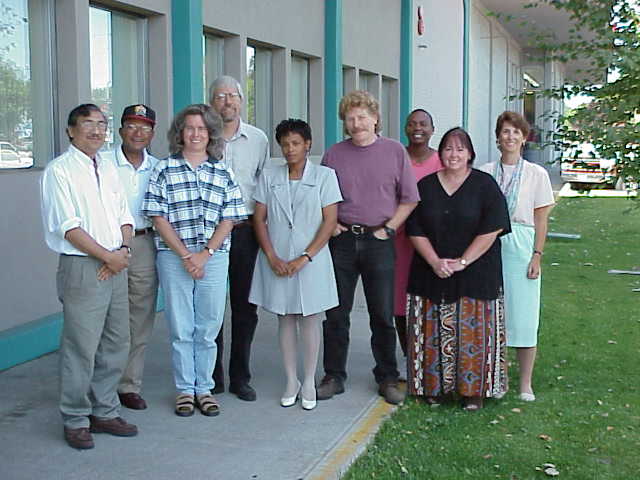
Innovative Solutions Archive
July - September 2000
Groundwater Remediation At Hanford
The decades-long production of plutonium at the Hanford Nuclear Reservation created enormous plumes of groundwater contaminated by hazardous and radioactive pollutants. A number of these plumes are discharging chemicals harmful to aquatic life directly into the Columbia River. In addition, roughly half of the 180 square miles of contaminated groundwater area exceeds drinking water standards.
 |
| Groundwater Team Members: (From left to right) Dib Goswami, Shri Mohan, Alisa Huckaby, Jerry Yokel, Deborah Singleton, Stan Leja, Zelma Jackson-Maine, Brenda Becker-Khaleel, Jane Hedges. Not Pictured: Chuck Cline, Suzanne Dahl, Wayne Soper, Nancy Uziemblo |
Staff in our Hanford Office, the Department of Energy and their various contractors has been working on innovative technologies as well as conventional pump and treat methods to reduce or contain the contaminated groundwater. One innovative approach involves a treatment barrier created by injecting a reducing agent into the aquifer that converts highly toxic chromium VI to chromium III, which is significantly less toxic and immobile in the soil and groundwater. Other innovative technologies are being investigated for the remediation of carbon tetrachloride, strontium 90, tritium and Iodine 129.
| Results | Before | After |
| Reduction of chromium VI levels in the Columbia River as a result of the treatment barrier (In Situ). | 2000 ppb | <5 ppb |
| Life cycle costs: pump and treat vs. In Situ reduction for chromium treatment. | $15.3 M for a single plume | $3.6 M for a single plume |
| Liters of groundwater pumped and treated for the removal of carbon tetrachloride, uranium, technetium, strontium and chromium since 1995. | x | 3 Billion Liters |
Project Contact: Dib Goswami, (509) 736-3015
More Innovative Solutions!
| EDUCATING
HOMEOWNERS ON SEPTIC TANK MAINTENANCE Problem/Solution Failing on-site septic systems pose a health risk to people and the environment. Homeowner education on how to keep septic systems in good working condition is critical. Staff in our National Research Reserve in Padilla Bay produced a multimedia education kit for homeowners that was originally intended for use at the 23 other national research reserves. |
Results
-
The Kit recently won a national Watershed Awareness Award and recognition for "one of the best we've seen" in public education.
-
The US Department of Commerce offered to produce and distribute the Septic Education Kit nationwide - 87 kits have been purchased in the last 6 months.
Team Members: Padilla Bay - Cathy
Angell, Glen Alexander, Terry Stevens
Project Contact: Cathy Angell, (360)
428-1558
| VOLUNTEER MONITORING FOR GROUND WATER CONTAMINATION |
Problem/Solution
Extensive nitrate contamination of ground water exits in Whatcom County. To help evaluate cost reductions in field sampling, staff piloted two methods: volunteer monitoring and use of commercial field test kits.Results
- Volunteer monitoring produced very comparable test results with Ecology collected co-samples and the costs were about $20 cheaper per sample. This project demonstrates the feasibility of using volunteers for basic monitoring to the scientists in our organization.
Team Member: Environmental Assessments Programs (Lacey): Denis Erickson
Project Contact: Denis Erickson, (360) 407-6767
| MAKING WATER DATA MORE ACCESSIBLE |
Problem/Solution
A statewide tabular water rights point-of-use database was linked geographically to the land. A critical piece of information was missing - how much water was permitted for withdrawal. Staff in our Central Regional Office enhanced the database to include both the point of where water is diverted and the amount permitted for diversion.Results
Research on estimating the quantity of water and the location permitted for withdrawal is greatly enhanced.
- Better decision-making by Ecology staff and local watershed planning groups.
Team Members: Water Resources (Yakima): Ron Dixon and Nicholas Riddle
Project Contact: Ron Dixon, (509) 454-7897
| ELIMINATING A SOURCE OF MERCURY IN THE ENVIRONMENT |
Problem/Solution
Mercury, a highly toxic substance, is used in some dairy milking systems for measuring pressure. The equipment is open shaped which allows for mercury vapor emissions and spillage. Staff, in cooperation with the Department of Agriculture and WSU Cooperative Extension, came up with a voucher system to replace the equipment free of charge to dairy operators.Results
Up to 100 pounds of mercury will be removed from the environment.
- Up to 150 dairy operators will receive the new replacement equipment at a savings of $225 each to the dairy.
Team Members: Ecology: Holly Cushman; Washington State University Cooperative Extension: Ned Zaugg; Department of Agriculture: Jim Pressley
Project Contact: Holly Cushman, (509) 575-2724
| SHARING DATA BETWEEN GOVERNMENT AGENCIES |
Problem/Solution
Government agencies with similar missions often maintain similar data. Ecology led a nationwide effort to develop data standards and a set of common practices for managing and exchanging data about facilities. This work is further being enhanced through an effort with a private Geographic Information Software Company to incorporate the standards into their mapping software.Results
Data comparability and standards between states regarding facility information (name, nature of business, location, business owner, etc.)
- Enhanced data exchange: Ecology recently sent our data regarding facilities to Spokane, Spokane "cleaned-up" the data and returned the 1,000 records to us. Both organizations have more reliable facility data as a result.
Team Members: Information Service (Lacey); Joy Denkers, Lynn Singleton, and John Tooley
Project Contact: Lynn Singleton, (360) 407-6610